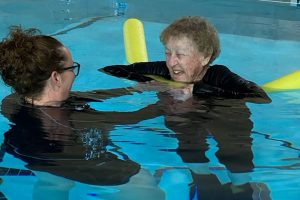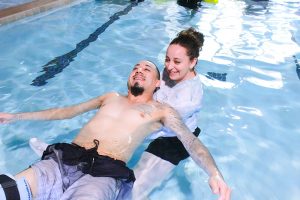What is aquatic therapy?
 Aquatic therapy is a physical therapy that is administered in a pool of water for the purpose of relieving pain and pressure on various joints, organs and other body parts. The aquatic therapy pool at Las Cruces Comprehensive Rehabilitation is a therapeutic 92 degree salt water pool that can be used for all types of physical therapy for people with many different conditions and injuries. Aquatic therapy is beneficial before and after knee and hip replacement therapy, for athletes who have suffered injuries, for pulmonary patients, for post surgical back patients, for those with chronic conditions and chronic pain, and for many others who would benefit from therapy. The advantage of aquatic therapy over other types of physical therapy is that the exercises can be done in a non-weight bearing environment. In addition, according to Johns Hopkins Medical, warm water therapy can help reduce pain and increase blood flow. Through the use of handrails, Hoyer lifts, and shallow water, even those with limited mobility can benefit from aquatic therapy with the help of the licensed therapists and licensed therapy assistants at Las Cruces Comprehensive Rehabilitation.
Aquatic therapy is a physical therapy that is administered in a pool of water for the purpose of relieving pain and pressure on various joints, organs and other body parts. The aquatic therapy pool at Las Cruces Comprehensive Rehabilitation is a therapeutic 92 degree salt water pool that can be used for all types of physical therapy for people with many different conditions and injuries. Aquatic therapy is beneficial before and after knee and hip replacement therapy, for athletes who have suffered injuries, for pulmonary patients, for post surgical back patients, for those with chronic conditions and chronic pain, and for many others who would benefit from therapy. The advantage of aquatic therapy over other types of physical therapy is that the exercises can be done in a non-weight bearing environment. In addition, according to Johns Hopkins Medical, warm water therapy can help reduce pain and increase blood flow. Through the use of handrails, Hoyer lifts, and shallow water, even those with limited mobility can benefit from aquatic therapy with the help of the licensed therapists and licensed therapy assistants at Las Cruces Comprehensive Rehabilitation.
Who can benefit from aquatic therapy?
Aquatic therapy can be beneficial for almost every type of therapy patients. From kids to the elderly, all ages and abilities can complete aquatic therapy. Aquatic therapy is beneficial for those with chronic conditions, such as:
- Fibromyalgia
- Multiple Sclerosis
- Arthritis
- Bursitis
- Parkinson’s
- Tendonitis
- Cerebral Palsy
- Back pain
- Pulmonary condition
It is also very beneficial for those who have had injuries or surgeries, such as:
- Knee replacement
- Hip replacement
- Back surgery
- ACL tears
- Orthopedic injuries, such as dislocations, fractures, breaks, sprains, strains and tears
- Pre- and post- surgery
What are the benefits of aquatic therapy?
 Aquatic therapy with the licensed therapists at Las Cruces Comprehensive Rehabilitation can provide many benefits for all types and ages of patients. Many patients will be begin with therapy in the water and progress to land-based therapy as they progress in their therapeutic goals. By beginning with aquatic therapy, patients can begin therapy in a non-weight bearing environment. This can relieve the stress on muscles and joints allowing patients to work on range of motion exercise without the pressure from their weight on the injured area. This allows patients to unload and ease their pain while working on strengthening muscles, increasing range of motion and building tolerance to therapeutic exercise. In addition, the warm salt water can be therapeutic and can reduce pain and swelling, as well as lower blood pressure. It can also improve circulation and flexibility. Salt water is also better for the skin and joints than chlorinated pools. It has stress relieving properties and makes it easier to breathe than chlorine. Aquatic therapy can be used for patients with limited mobility with the use of lifts and rails. In addition, it is appropriate for patients of all ages.
Aquatic therapy with the licensed therapists at Las Cruces Comprehensive Rehabilitation can provide many benefits for all types and ages of patients. Many patients will be begin with therapy in the water and progress to land-based therapy as they progress in their therapeutic goals. By beginning with aquatic therapy, patients can begin therapy in a non-weight bearing environment. This can relieve the stress on muscles and joints allowing patients to work on range of motion exercise without the pressure from their weight on the injured area. This allows patients to unload and ease their pain while working on strengthening muscles, increasing range of motion and building tolerance to therapeutic exercise. In addition, the warm salt water can be therapeutic and can reduce pain and swelling, as well as lower blood pressure. It can also improve circulation and flexibility. Salt water is also better for the skin and joints than chlorinated pools. It has stress relieving properties and makes it easier to breathe than chlorine. Aquatic therapy can be used for patients with limited mobility with the use of lifts and rails. In addition, it is appropriate for patients of all ages.
Is aquatic therapy safe if I do not know how to swim?
Aquatic therapy is safe for patients who have no swimming ability. Therapy can be performed in shallow water and with the use of handrails. In addition, someone is always in the water with the patient. Hoyer lifts can be used for patients with limited mobility, so even they can safely take advantage of the many benefits of aquatic therapy. In addition, Las Cruces Comprehensive Rehabilitation also has a Jacuzzi area that can be utilized for aquatic therapy. People of all ages and abilities can feel comfortable and safe while receiving the many advantages of aquatic therapy.
What should I expect during my first appointment?
As with all new patients, Las Cruces Comprehensive Rehabilitation will begin with an evaluation of the patient to set up goals and expectations, based on the doctor’s referral, the type of injury and the patient’s goals and needs. An individualized therapy plan is made for each patient and patients are then scheduled out for their sessions several weeks in advance, so they receive the best continuity of care. Patients will then be acclimated and made comfortable in the water with basic exercises. They will start slow and therapists will progressively challenge them. Open communication is very important throughout the process and therapists always want patients to feel comfortable expressing their needs and goals. Throughout their course of sessions, therapists build relationships with their patients and always communicate progress back to the patient’s doctor. Most patients receive one hour session 2-3 times a week of aquatic therapy.
What equipment is used during aquatic therapy?
Patients will receive aquatic therapy in the Jacuzzi area or the warm, salt water pool set at 92 degrees. The pool has shallow, medium and deep areas that may be utilized depending upon the needs of the patient. Hoyer lifts can be used for patients with limited mobility. Handrails are also used for the comfort and safety of the patient. During the course of therapy, weight vests, ankle weights and flotation devices may be used with the patient, depending on their therapeutic needs. All equipment is kept clean and well maintained for the safety and comfort of patients.
